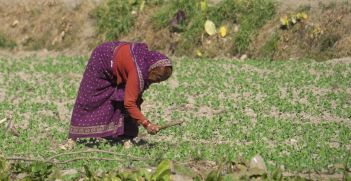How Australia can Step up its Efforts to Support India’s COVID-19 Response
The Indian diaspora is the fastest growing in Australia. The Australian government’s recent discriminatory response to citizens attempting to return to Australia has presented challenges to Australia-India relations.
The COVID-19 emergency in India, which some have deemed a “crime against humanity,” has worsened, with the country recording over 412,000 new cases last week. For weeks, the Indian healthcare system has been overwhelmed, with reports recording the lack of hospital beds, the severe shortage of oxygen, ventilators, and vaccines, delays in processing test results, and a dangerous dearth of Remdesivir, the most widely used antiviral medication in the country. The situation seems bleak at best, and the lack of a nationwide lockdown means that cases will likely continue to rise over the next few weeks.
The international community has started sending help, with countries across the world donating both money and resources to help save lives in India. Notably, Germany provided 23 mobile oxygen generation plants for use in military units tending to COVID-19 patients. Pakistan offered ventilators and medical equipment. The Saudi government sent 80 metric tons of liquid oxygen. Singapore donated four cryogenic oxygen tanks. The UK rushed 140 ventilators and 495 oxygen generators. And the US is planning to send additional oxygen supplies, COVID-19 tests, drug treatments, and personal protective equipment (PPE), in addition to the $5.9 million in COVID-19 relief it provided in April last year. The US is also planning to fly out teams of medical experts and supply India with raw materials to enable the independent manufacturing of the AstraZeneca vaccine.
Australia has contributed to this international response, with Australian Health Minister Greg Hunt announcing the decision to send oxygen, ventilators, and PPE kits to India. Simultaneously, the Australian government has been attempting to introduce a contentious policy that would potentially criminalise Australian citizens in India trying to get home with heavy fines and jail time of up to five years. This severe lack of coordination between intent and policy raises serious concerns about Australia’s treatment of its citizens and its commitment to supporting its “natural ally” and Quad partner, all of which will have a bearing on Australia-India relations going forward.
Australia and India have long enjoyed a strong relationship based on economic, diplomatic, and people-to-people links. Most notably, India is Australia’s largest source of skilled migrants and provides the second-largest source of international students (96,000 student enrolments), contributing $6.6 billion to the Australian economy in 2020. Over the past five years, the number of overseas-born migrants from India grew more than any other group in Australia, increasing from 449,000 to 721,000. As of 2020, the Indian diaspora is the fastest growing, with Indian-born persons representing 1 in 50 people in Australia. India is Australia’s sixth-largest two-way trading partner, with the 2011 Australia-India Comprehensive Economic Cooperation Agreement laying the strong foundation for Australia’s efforts to deepen bilateral economic relations. The strong diplomatic ties between both countries are exemplified in a speech given by then Australian Foreign Minister Stephen Smith, who said “Perth and Chennai are closer to each other than Sydney is to Seoul, to Shanghai, or to Tokyo… As the world sees the potential of an Asian/Pacific century unfold, Australia sees India at the heart of this historic shift in political and economic influence.”
However, Australia’s recent attempt to criminalise Australians’ efforts to return home from India under a Biosecurity Act is insensitive and discriminatory, impinging both on the fundamental human right to move and the right of citizens to return home. No such measure was considered when the US and the UK were reporting more cases per capita and were responsible for a greater share of overseas-acquired cases during their peaks in Australia. Why was there no cause for concern then, and is there a reasonable justification for initiating such an extreme pre-emptive response regarding India?
This is not a single-issue problem and points to a consistent trend of Indian-Australians being treated as second-class citizens. It is important to remember the series of racially motivated attacks against Indian students in Melbourne in 2010 which devastated the community. Taken within the context of this sensitive history, the government’s response has been unacceptable. If the government is equally concerned about Aussies stuck in India as those stuck in the US and UK, it should allow them to enter Australia.
Australia recently pledged to send over 500 ventilators, 1 million surgical masks, 500,000 P2 masks, 100,000 surgical gowns, 100,000 pairs of goggles, 100,000 pairs of gloves, 20,000 face shields, and 100 oxygen concentrators to India. Additionally, the government of Western Australia set a positive precedent by donating $2 million in relief funding to support on-the-ground efforts, including providing medical supplies and PPE, installing oxygen concentrates in hospitals, sourcing ventilators, and supporting local charity organisations directly supporting affected families. Most recently, the Victorian government pledged to send $41 million. Apart from monetary aid, Australia can provide valuable and expert advice to train Indian policy professionals, government officials, and data collecting bodies about effective contact tracing, quarantine measures, data collection and standardisation, case modelling, mask hygiene, and vaccine education campaigns.
Australia could consider vaccine diplomacy, which presents the potential for collaboration in research, technology, and providing affordable raw materials for vaccine production, by supporting India’s call for the temporary suspension of the Trade-Related Aspects of Intellectual Property Rights (TRIPS) agreement to allow least developed countries (LDCs) to manufacture cheap vaccines for their populations. After initially refusing India’s appeal last October, Australia briefly joined New Zealand and Canada in urging the World Trade Organization to assist individual countries to negotiate with pharmaceutical companies. However, LDCs are still liable to pay for rights to vaccine formulas.
The higher education sector in Australia can also play a major role. Despite the overall lack of empathy and support and a centralised response to supporting the international student cohort last year, Australian universities now have the chance to proactively support their Indian student community, which is currently experiencing mental anguish and stress. Feasible options include providing free or subsidised mental health services and enhanced study support resources, which demonstrate that Australia values its Indian student community upon which it is highly reliant economically.
India’s COVID-19 nightmare is far from over, and the biggest strength of our overarching global system is its ability to respond to crisis and transcend the idea of a nation-state to ensure resources are somewhat equitably shared. Australia has both an interest in and incentive to help ensure that India does not get left behind.
Aasha Sriram is a Master of International Relations student at the University of Melbourne interested in migration, social policy, and development issues. She is also a Co-Researcher studying food insecurity on Australian campuses at the Melbourne Social Equity Institute. Aasha has experience working as a writer and project officer in community development in India and Kenya. Currently, Aasha works as a Communications Officer at the Energy Efficiency Council. With journalism and media experience, Aasha has written about public policy issues surrounding international students and food insecurity for The Conversation, Pursuit Magazine, and Times Higher Education.
This article is published under a Creative Commons License and may be republished with attribution.





